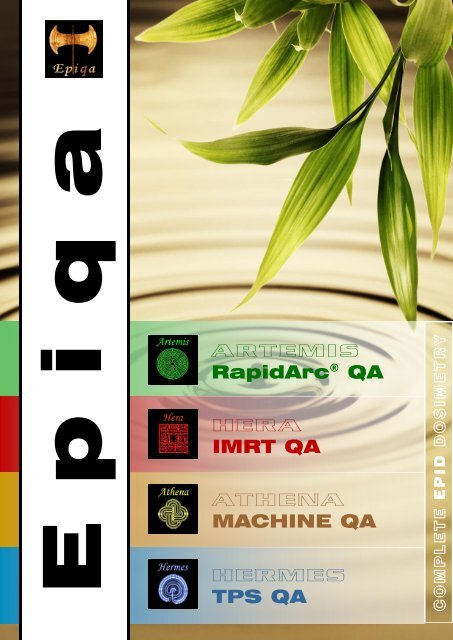PATIENT plan Rapidarc QA - Epidos
PATIENT plan Rapidarc QA - Epidos
PATIENT plan Rapidarc QA - Epidos
Create successful ePaper yourself
Turn your PDF publications into a flip-book with our unique Google optimized e-Paper software.
E p i q a<br />
ARTEMIS<br />
RapidArc ® <strong>QA</strong><br />
HERA<br />
IMRT <strong>QA</strong><br />
ATHENA<br />
MACHINE <strong>QA</strong><br />
HERMES<br />
TPS <strong>QA</strong><br />
COMPLETE EPID DOSIMETRY
E p i q a<br />
Epiqa TM is a program that allows to convert a dosimetric image acquired by an EPID into a dose map<br />
and to compare the dose map with a reference dose distribution. It is possible to utilize Epiqa for a<br />
verification of static as well as intensity modulated fields, including RapidArc ® fields.<br />
The conversion of a dosimetric image into a dose map is only possible if a response of the imager to a<br />
beam is known. The EPID’s response shows very good linearity, but exhibits rather strong energy<br />
dependence, which causes a difference in response to primary and MLC transmitted radiation. Epiqa<br />
overcomes this limitation by the calibration process that takes the energy dependence of the detector<br />
into account. For the purpose of calibration, a set of integrated images for open and transmission fields<br />
of different field sizes are acquired and consequently imported into Epiqa together with the output factor<br />
table (measured by a conventional detector such as ionization chamber) to establish basic algorithm<br />
configuration data.<br />
Based on the knowledge of jaws position and the trajectory of MLC leafs (for an IMRT field),<br />
a calibration factor can be determined for every pixel of an EPID by weighting the contribution of primary<br />
and transmitted radiation and by applying an interpolation among the data of the calibration dataset.<br />
The pixel based calibration relates the readout of a pixel to a dose at the depth of d max in water<br />
equivalent homogenous medium. By applying the conversion to all pixels of the EPID, a <strong>plan</strong>ar dose<br />
distribution at the dmax in water is obtained.<br />
The image-to-dose conversion algorithm (GLAaS) is often confused with portal dose image prediction<br />
algorithms (PDIP). As described in the previous paragraphs, the GLAaS derives calibration factors for<br />
EPID’s pixels using empirically measured dataset. The obtained dose map is compared against dose<br />
distribution calculated by clinically used dose algorithm<br />
(typically AAA). It is therefore an independent method of<br />
verification of the dose distribution calculated by a<br />
treatment <strong>plan</strong>ning system and verification of the delivery<br />
device performance. The PDIP estimates a response of<br />
the imager for the theoretical incidental fluence. In other<br />
words, the algorithm predicts a pattern that will be<br />
created on the imager and a user has then a possibility to<br />
compare it with the real one. This method checks the<br />
reproducibility in delivery of the incidental fluence,<br />
meaning it verifies the technical accuracy of the delivery<br />
(which is usually very good) and not the dose<br />
distribution/dose calculation algorithm itself.<br />
A detailed description of the GLAaS image-to-dose<br />
algorithm can be found in [1].<br />
Epiqa benefits<br />
resolution comparable to film dosimetry<br />
no phantom and no build-up needed<br />
very good long term stability<br />
independent of TPS<br />
calibration based on data measured by user<br />
Reference<br />
[1] Nicolini G, et al.: GLAaS - an absolute dose calibration algorithm for an amorphous silicon portal imager.<br />
Applications to IMRT verification. Med Phys 2006; 33: 2839-2851.<br />
Epiqa TM is a trade mark of EPIdos s.r.o.<br />
RapidArc ® is a registered trade mark of Varian Medical Systems, Inc.
RapidArc <strong>QA</strong><br />
Use your portal imager as absolute dosimeter to verify RapidArc <strong>plan</strong>s following these steps<br />
Replace patient 3D model with water phantom and<br />
reset gantry angles to zero for dose calculation<br />
Calculate verification <strong>plan</strong> using YOUR CLINICAL<br />
dose calculation algorithm<br />
DICOM export dose <strong>plan</strong>e at dmax as a reference<br />
matrix<br />
Deliver the RapidArc <strong>plan</strong> normal way while<br />
acquiring integrated image<br />
Compare calculated versus acquired dose matrices<br />
using Epiqa<br />
<strong>PATIENT</strong> <strong>plan</strong> RapidArc <strong>QA</strong><br />
Benefits of using Epiqa for RapidArc <strong>plan</strong> <strong>QA</strong><br />
Simple <strong>QA</strong> <strong>plan</strong> preparation<br />
Instant detector preparation for measurement - just<br />
deploy Portal Vision arm<br />
Easy <strong>QA</strong> <strong>plan</strong> delivery - can be performed by<br />
therapist<br />
Fast data export - export only 4 DICOM objects<br />
The method verifies not just the delivery device but<br />
also TPS performance<br />
Quick results evaluation. In just few minutes user<br />
can print final protocol for approval<br />
Reference<br />
[1] Nicolini G. et al: The GLAaS algorithm for portal dosimetry and quality assurance of RapidArc, an intensity modulated rotational therapy, Radiation Oncology 2008, 3:24 .<br />
ARTEMIS
ARTEMIS<br />
RapidArc<br />
Machine <strong>QA</strong><br />
MACHINE commissioning for RapidArc<br />
Verify accelerator and MLC performance using standard tests recommended by Varian.<br />
Use Portal Vision dosimetry acquisition and Epiqa to evaluate results.<br />
1. Accurate control of dose rate for several gantry speeds<br />
and 7 different dose rates. Each strip is delivered with<br />
30 MU and ROI is analyzed for its average value and<br />
standard deviation.<br />
2. Precise MLC positioning during gantry<br />
rotation. Picket fence test is performed<br />
using sliding window technique while<br />
gantry rotates over 330 degrees.<br />
Epiqa allows visual and qualitative<br />
analysis of the performance of each<br />
leaf pair separately.<br />
3. Accurate control of MLC leaf speed during gantry rotation for 4 different leaf speeds. Results of this<br />
tests are influenced by correct performance of MLC motions but also by gantry speed and correct<br />
dose rate. Each of the 4 strips are irradiated for 30 MU with the combination of different leaf speed,<br />
dose rate and gantry speed. ROI is analyzed for its average value and standard deviation.
Test IMRT <strong>plan</strong> delivery versus TPS<br />
calculation in the treatment gantry<br />
position<br />
Replace patient 3D model with<br />
water phantom and calculate dose<br />
distribution per field separately<br />
Calculate verification <strong>plan</strong> using<br />
YOUR CLINICAL dose calculation<br />
algorithm<br />
DICOM export dose <strong>plan</strong>e at dmax<br />
as a reference matrix<br />
Deliver the IMRT <strong>plan</strong> normal way<br />
while acquiring integrated image for<br />
each field<br />
Compare calculated versus<br />
acquired dose matrices using Epiqa<br />
IMRT <strong>QA</strong><br />
IMRT <strong>PATIENT</strong> PLAN & DYNAMIC MLC QUALITY ASSURANCE<br />
Patient <strong>plan</strong> IMRT <strong>QA</strong><br />
Measured Dose Gamma Map<br />
Calculated Dose<br />
Verify dynamic MLC performance using classic tests recommended in the literature.<br />
Use Portal Vision dosimetry acquisition and Epiqa to evaluate results.<br />
Leaf speed test evaluation - TPS vs. measurement or long term stability<br />
comparison.<br />
Example of some evaluation tools<br />
Profiles comparison<br />
Point evaluation - dose difference, gamma<br />
Results histogram and statistics<br />
Flexible definition of local or global gamma criteria<br />
Chair test evaluation *<br />
Dynamic leaf gap and leaf<br />
transmission are key<br />
parameters for correct modeling<br />
of sliding window field<br />
calculation. Epiqa provides<br />
qualitative analysis of calculated<br />
vs. measured chair test field to<br />
investigate correct values.<br />
*The sliding slit test for dynamic<br />
IMRT: a useful tool for adjustment<br />
of MLC related parameters<br />
I Chauvet et al 2005 Phys. Med.<br />
Biol. 50:563<br />
Reference<br />
[1] Nicolini G, et al.: GLAaS - an absolute dose calibration algorithm for an amorphous silicon portal imager. Applications to IMRT verification. Med Phys 2006; 33: 2839-2851. to IMRT<br />
verification. Med Phys 2006; 33: 2839-2851.<br />
HERA
Machine <strong>QA</strong><br />
MACHINE AND TPS COMMISSIONING & QUALITY ASSURANCE<br />
Machine <strong>QA</strong> module provides physicist with following tools<br />
Beam symmetry and homogeneity evaluation - determination of the core beam parameters and its long term<br />
stability. 2D map comparison of the reference and measured dose map provides instant results for your<br />
morning checkout protocol.<br />
Profile Analysis Window<br />
Example of OPEN FIELD analysis<br />
Solid line - Eclipse<br />
Dashed line - measurement<br />
Beam energy stability verification - using small build up phantom placed on the surface of the imager.<br />
Analysis of single phantom image provides dose information of 4 different depths along the depth dose curve<br />
measured in water.<br />
Qualitative analysis of the TPS performance after initial beam data collection - by comparing calculated<br />
open fields and wedged fields module Athena provides great help to quickly asses TPS output with the real<br />
beam without need to use film or water phantom.<br />
Open field evaluation - TPS vs. measurement comparison<br />
at 2D level.<br />
Reference<br />
[1] Nicolini G, et al.: Testing the portal imager GLAaS algorithm for machine quality assurance. Radiation Oncology 2003; 3:14.<br />
Wedge field evaluation - mechanical and<br />
dynamic wedge calculation vs. measurement<br />
analysis using profiles<br />
and gamma method<br />
based on dose maps.<br />
Measured Dose<br />
Gamma Map<br />
ATHENA
`<br />
TPS Algorithm<br />
Performance Evaluation<br />
Module Hermes supports treatment <strong>plan</strong>ning system algorithm performance evaluation<br />
supporting following use cases<br />
Quantitative comparison of calculated 2D dose matrices provides independent information about results<br />
calculated with different calculation options<br />
Use Epiqa for continuing TPS <strong>QA</strong> by comparing equal calculations in the past and today, e.g. after Eclipse<br />
upgrade<br />
TPS quality assurance testing by comparing calculation result obtained by different calculation algorithms,<br />
e.g. PBC vs. AAA<br />
1. Example of calculation matrix influence - comparison of the AAA algorithm results for calculation<br />
matrix 2.5 (right) vs. 5 mm (left).<br />
2. Example of calculation algorithm influence - comparison of the AAA algorithm results (right) and<br />
PBC algorithm (left).<br />
HERMES
COMPLETE EPID<br />
DOSIMETRY<br />
Lesna 7<br />
Ivanka pri Dunaji<br />
Slovak Republic<br />
www.epidos.eu<br />
Phone: +421-2-459 454 41<br />
E-mail: epiqa@epidos.eu



